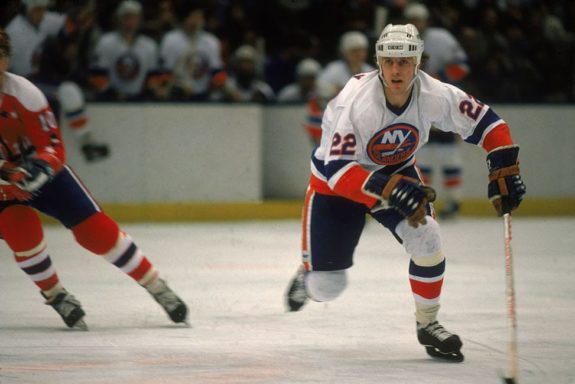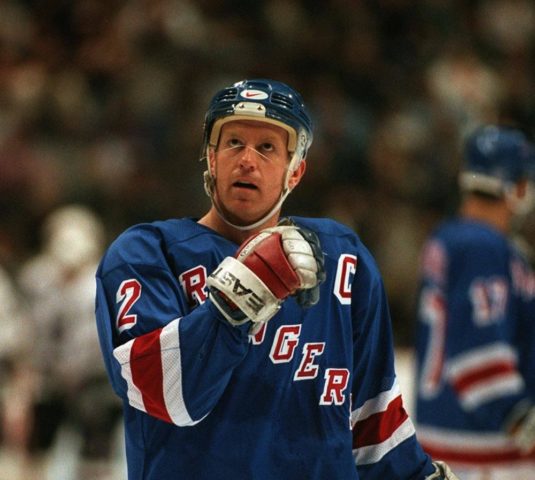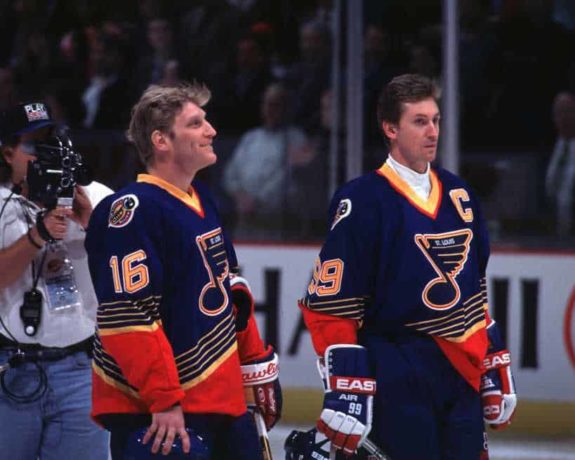The NHL’s impending return will be welcomed by hockey fans everywhere, as strange as it will be to watch players on the ice in July and August. Still, the real games of this unprecedented playoff tournament remain some time away, so here’s a little historical trivia to help bridge the gap from now until then.
Nine Hall of Famers, One “Outlier”
Q: 10 players in NHL history have reached the 50-goal mark in at least four consecutive seasons. Nine of them are in the Hockey Hall of Fame. They are Phil Esposito, Marcel Dionne, Guy Lafleur, Wayne Gretzky, Mike Bossy, Michel Goulet, Jari Kurri, Steve Yzerman and Brett Hull. Who is the 10th?
A: Tim Kerr. The erstwhile power-play monster – he led the league in man-advantage goals for three straight seasons with a total of 81 – proved a nightmare for penalty-killing units in the mid-1980s, as he scored 54, 54, 58 and 58 goals from 1983-84 through 1986-87 for the formidable Philadelphia Flyers clubs of that time. Unlike most of his dynamic, high-octane peers on this list, the 6-foot-3, 230-pound forward who went undrafted in 1979 did his damage from the dirty areas, setting up in front to bang in rebounds and tip in shots from the point as a nearly immovable presence from the goalmouth.

Kerr also excelled in the playoffs, his close-in game and special-teams acumen making him a commodity when scoring became more scarce during the tournament. Kerr totaled 40 goals and 31 assists in 81 postseason games, with 21 of those goals coming on the power play. He led all players in PP goals during the 1987 postseason with five, when he had 13 points in 12 playoff games. In the 1989 playoffs, his eight goals with the man advantage were again the most in the NHL, and he recorded 14 goals and 11 assists in 19 postseason contests that year. He scored 10 goals in 12 playoff games in 1985.
Related: The 5 Greatest Goaltenders in NHL History
During the first round of the 1985 playoffs, Kerr set an NHL record with four goals in an 8:16 span of the second period of a 6-5 victory over the New York Rangers – a mark that still stands.
Despite accomplishing the extremely rare feat of recording four straight 50-goal seasons, Kerr never had a realistic chance to reach the Hall of Fame like his counterparts, a who’s who of hockey greatness, did. Though he did turn in a 48-goal effort in 1988-89 – with 25 of those coming on the power play – Kerr managed only 146 goals outside of the 224 he scored during his 50-goal campaigns. That was because of the 1987 postseason, when he suffered a shoulder injury that kept him out of the Eastern Conference finals and Stanley Cup Final, which the Flyers lost in seven games to the Edmonton Oilers.

Kerr subsequently underwent five shoulder operations in 14 months, crippling his career. He was limited to eight games in 1987-88, and his 69 contests in 1988-89 were the most he would play over his final six years after the 50-goal seasons.
Though his career is hardly comparable to the other nine players to string together four straight seasons of 50 or more goals, Kerr was a dominant player when healthy. At first glance, he appears to be the outlier in a group made up of some of the most prolific offensive players in NHL history, but his four-season run of wreaking havoc from the slot was hardly a fluke.
The Ultimate Plus Player
Q: What player easily holds the NHL record for plus-minus?
A: Larry Robinson. The hulking defenseman’s control of this category is Gretzky-esque – at plus-722, he’s an astounding 140 better than second-place Bobby Orr at plus-582. While Orr holds the single-season record of plus-124 and also possesses the highest two-season total at plus-207, Robinson’s longevity and incredible consistency made this race one-sided. The Hall of Famer nearly matched Orr’s best effort with a career-high plus-120 in 1976-77, and he was a plus player every season of his 20-year career.

Though he never approached plus-120 again, Robinson’s presence on the ice meant the Montreal Canadiens (and later, the Los Angeles Kings for his final three seasons) were going to score more goals than their opponents for two decades – providing the powerful argument that Robinson was the greatest pure defender in history.
Related: A Royal Celebration – All-Time LA Kings By Country
Robinson played in the playoffs every season of his career – tying him with Nicklas Lidstrom of the Detroit Red Wings for the NHL record with 20 straight such seasons – and was a plus-100 in 227 games, winning six Stanley Cups with the Habs.
As an aside, it should be noted how incredible it is for Orr to occupy second place on this list. No. 4’s incomparable career was essentially compressed into eight overpowering seasons, with a myriad of injuries limiting him to 82 games over the other four he played. From 1968-69 through 1974-75, Orr was at least a plus-55 each season and plus-80 or better four times as part of what was arguably the most dominant extended stretch by any player in NHL history.
Triple Digits From the Blue Line
Q: Who was the last defenseman to record 100 points in a season?
A: Brian Leetch. Extending forward from Orr’s legacy and revolutionary effect on the game, Leetch totaled 102 points (22 goals, 80 assists) in 1991-92. The Rangers Hall of Famer’s timing was just right, as he turned in his career season as the high-octane offensive ways of the 1980s and early 1990s were starting to wane.

For his part, Leetch doesn’t see the mark being reached again by a defender unless the NHL undergoes a retroactive change in style of play.
The Two Biggest Guns
Q: Wayne Gretzky holds the record for most goals in a four-season span, piling up 323 from 1981-85. Who totaled the second-most over four years?
A: Brett Hull. The Golden Brett is the only other player to record three consecutive seasons of at least 70 goals, scoring 72, 86 and 70 from 1989-90 through 1991-92 and adding 54 more in 1992-93 to give him 282 in that stretch for the St. Louis Blues.

While Hull scored “only” 41 fewer goals than Gretzky during his four-season offensive outburst, The Great One had 367 more points than Hull during that incomparable 1981-85 stretch.